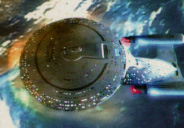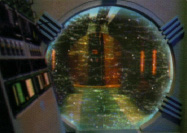 |
|
 |
|
|
|
|
|
| Resource Profile |
| resource type |
|
| Technology |
| resource series |
| All Series |
|
Also known as deflectors, deflective shields or screens, shields are a high energy field projected to envelope or enclose an area and protect from potential dangers. Shields can act in one of two ways: to deflect energy away from an area or to absorb energy into a containment system for gradual release.
Deflector systems, making up the bulk of force field devices, generate localized zones of highly focused spatial distortion within which an energetic graviton field is maintained. The deflector system is made up a of a series of emitters placed around the area to be protected, shaping the field in a conformal transmission grid. This allows the shield to closely follow the contours of a protected area and increases efficiency. When a shield is activated and impacted upon, through material means or directed energy, field energy is concentrated at the point of impact, creating an intense, localized spatial distortion. Such a spatial distortion would appear to "deflect" the impact and be accompanied by a brief burst of Cerekov radiation in the blue light range.
The deflector is effective across a wide spectrum of electromagnetic, nuclear, and other radiated and field energies; however, protection from the entire spectrum of electromagnetic radiation consumes great amounts and not always wanted. While a ship (for example, the Starship Enterprise) is always shielded at a low level (approximately 5%), only alert situations would bring shield output up to the recommended level 85% of rated output.
Alert situations and the increased shield output bring a sizable set of problems to the operation of a starship. While the deflector shields do protect the ship from danger, the shields also block valuable sensor data. For this reason, shield frequencies are modulated in tandem with sensor sweeps to optimize the "window" of shield decay. Shield frequency modulation and bandwidth are varied often. This variation should disallow an enemy from taking advantage of the shield decay "window"; however, it would be possible for an attacking ship to match their directed energy weapons frequency and phase with a starship's shields and penetrate the deflector area. Fortunately, this likelyhood is extremely remote.
Transporter systems are also dramatically affected by deflector shields. The annular confinement beam that serves as a part of the transmission medium for the transporter has a vary wide EM bandwidth, dissallowing for its use while under alert shields situations. Additionally, the transporter beams pattern integrity could be severely compromised due to the shield's spatial distortion; however, due to the shield decay "window", a very skilled transporter operator with intimate knowledge of a deflector system's shield frequency and modulation could possibly beam through. Again, the likelyhood is extremely remote.
Warp drive operations are also significantly affected by shield use. The spatial distortion inherent in the shield process causes a measurable effect on the warp field geometry. This requires compensation by both systems' software drivers and an increase in power requirements. |
 USS Enterprise USS Enterprise's Shields React With A Planet's Atmosphere  Forcefield Used For Prisoner Containment |
| Resource By: | |
| Posted: |
2003.02.20 |
|
|
|
|
|
|
|
 |
. |
 |
|


|






